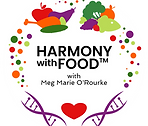What Your Physician May Not Have Told You About Cholesterol
- Meg ORourke, RD-LDN
- Jan 18, 2018
- 4 min read
Updated: Sep 25, 2020
New research has doctors reevaluating how they measure and use cholesterol to determine the risk of cardiovascular disease. People think of cholesterol in terms of “good” and “bad”.

Unfortunately, it is a little more complicated than that. My job is to make nutrition/health simple for you. Remember, I am all about being your own healthcare advocate. So let’s dissect cholesterol: The good the bad and the ugly.
You Should Love Cholesterol
Even though it has a stigma around it, cholesterol impacts more than your heart health. Created in your liver, it has a vital effect on testosterone, estrogen and progesterone (aka, the sex hormones), and it is critical to your brain function. It is involved in cell synthesis and is in your cell membranes. In addition, it plays a role in protecting you from bacterial infections. So don’t “hate” your cholesterol; it has a good side, too.
Serum cholesterol travels from the liver through your bloodstream inside lipoproteins. The two most abundant lipoproteins are low-density lipoprotein (LDL) and high-density lipoprotein (HDL). In the past, I would see clients/patients in my office and they would not even realize there was a HDL or LDL. Their physicians would just give them their total cholesterol number, which only tells you half the story.
Current recommendations are the following: HDL level should be 40 or above. However, if your cholesterol is 240 and your HDL is 40, you’re risk factor is a 6.0 (which is a very high risk). On the other hand, if your cholesterol is 240 and your HDL is 60, your risk factor level would be 4.0 (which is a very low risk). As any good attorney would say, “It depends.” You need the entire story to be able to assess your risk factor.
New Evidence: Medical experts used to think every LDL particle was identical and every HDL particle was identical, but they now know that's not true. Some labs can measure the number of LDL and HDL particles (rather than just how much cholesterol is carried by a person's LDL or HDL) and subclasses of LDL and HDL cholesterol, which have different sizes, compositions and varying effects on coronary artery disease. It is key to know the number of LDL particles (fewer is better) and the type. The worst kind of LDL is the small, dense LDL particle (type B), while the least harmful kind is the largest LDL particle (type A). Similarly, there are several types of HDL cholesterol, including small, dense HDL3 (which is believed to be the least protective against heart disease), and large, buoyant HDL2, (which appears to be the most protective against cardiovascular disease).
So, now what do you do?
Avoid saturated fats and diets high in carbohydrates. When you read the nutrition label on the back of any food product, you see a category for cholesterol. It is NOT the cholesterol in food that raises your risk factor levels; it is the saturated fat in food. Lower your risk of coronary vascular disease by sticking to red meat once a week (yes, just once). Additionally, the American Heart Association recommends limiting eggs to 7 per week.
Keep your sodium levels under 2,500. Quick Rule of Thumb: When reading those nutrition labels, make sure it has less than 300 milligrams of sodium per serving (for crackers, cheese, cereal etc.).
Pay attention to what you’re buying. Kentucky Fried Chicken has chicken with 12 grams of fat per ounce. You can buy a lean piece of chicken (super lean=1 gram of fat per ounce) or a chicken that has 5 grams of fat per ounce from the grocery store.
Same with goes for cheese. Cheese can vary from 0 grams-2 grams of fat per ounce (aka: diet cheese), but the only problem is that cheese will taste like rubber. Then there are high fat cheeses that can have 10 grams of fat per ounce. We want to stay in the middle. Another Quick Rule of Thumb: Look for cheeses that have 5-6 gram of fat per ounce. Here are some examples: string cheese, Alpine Lace, Babybel, Laughing Cow and cabot reduced fat cheeses ( but not as low as 0-2 grams of fat per ounce). So on a positive note...not all cheese is bad. Also, not all chicken is good.
Lastly, Men...You may want to listen up for this. You are at risk for erectile dysfunction. Remember how I said cholesterol is linked to testosterone? I talked about the connection between erectile dysfunction and cholesterol on my radio show a few weeks back, BUT if you missed it or have some questions, email me and I will try to answer them in my next post.
Also, You can go to my web site now and listen to any of my radio or cable shows at your convenience. Just click the “On radio” or “On TV” tab at www.harmonywithfood.com
XO,
Meg
Photo of food collage courtesy of Stuart Miles/ freedigitalphotos.net. Photo of me taken at the ribbon cutting ceremony for Hope & Main, Rhode Island's first kitchen incubator, of which I'm a BIG supporter. Learn more at makefoodyourbusiness.org.





.png)























Comments